| |
|
|
| |
|
VISITS |
|
755962 |
|
Copyright 2013
waypoints.ph |
|
|
Click on any of the images to see the enlarged copy and narratives of the photo.


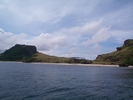
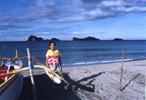
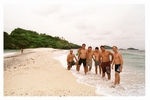
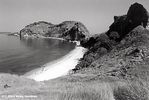
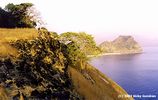
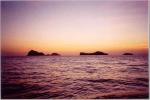
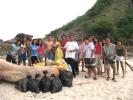
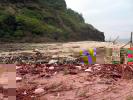
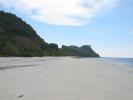

Capones Island and a couple of other smaller islands (the Camera Islands) lie a few kilometers from the shores of Pundaquit, Zambales. The Camera islands are 2km offshore and Capones is 3 kilometers farther (5.2 km offshore).
Capones and Camera are known for their white beaches, speckled with colorful crushed coral. Clear turquoise waters held us spell-bound.
High rock cliffs beckon rappellers. Capones is known for an old Spanish-era lighthouse that brings visitors back in time.
There are no resorts nor facilities on the island. Tourists usually stay
at a resort in Pundaquit, a small fishing village about 3 kms southwest of San Antonio where they can hire a boat to explore Capones Island.
How to go there
From Manila, take the North Expressway and exit at San Fernando. From San Fernando, head southwestward all the way toward Olongapo City. Right before the city boundary of
Olongapo, there is a bypass way via the Subic Base Metropolitan Authority (SBMA) which you may want to take to avoid passing through the city. Take this bypass road through SBMA then head northwestward to Subic town, Castillejos, then San Marcelino then westward to San Antonio.
At San Antonio, you will head southwestward to Pundaquit. At this point you may want to ask directions from the folks at San Antonio, on where to pass to reach the road that leads to Pundaquit as this road is behind rather circuitous village roads.
The road to Pundaquit is a narrow but amazingly well constructed concrete road. At Pundaquit proper, you will have several beach resorts to choose from. At these resorts, you can directly hire a fishing boat to take you to Capones Island.
Tips
Prepare for rough waters! The waters surrounding Capones Island in particular is known to be generally rough. It is relatively calm only on early morning up to near noon time. It is advised that you take a boat ride in the early morning and head back noon time at the latest. If you fear the rough open seas, you may want to just go to the Camera islands instead of venturing on further to Capones. The waters to Camera islands will be a bit less rough.
The fishing boats that you could hire are small and the boatmen tend to allow their boats to go dangerously near full load which makes the boats dangerous on rough seas. Do bring your own life jackets! Most boatmen in this village do not provide life jackets.
The white beaches move around! The white beaches move around throughout the year. Half of the year they are on one particular side of the island then on the other half, they move to another side! So do not be surprised if the beaches on the pictures above are no longer there when you go to Capones. Go to Capones during rainy season (June to Sept) and you will see the white beaches on the North side. Otherwise, you will find the beaches on the south side. Here's a nice tip: Go to the Camera islands near the end of the rainy season and you will get to enjoy a wonderful sandbar linking the two Camera islands! The sandbar's sand literally moves away (as in, not sink, but literally crawls away, pushed by changing currents) during the other months of the year.
While you are there, you may want to check out the waterfalls at Pundaquit.Waypoint narrative by: EPPGarcia 2002 follow EPPGarcia on Facebook
Additional narratives or blogs:
Capones was fun. My friends enjoyed it so much. The water was a little rough. What was frustrating was that it was not that clean when i last saw it. The garbage bags that we took to the island are very insufficient to get as many garbage. We're so frustrated we couldn't clean the whole island. :)By: LAOlpindo 2003
I chaperoned a group of students from DLSU-Manila (Outdoor Club Members) to Capones Island on June 3-4, 2006. The overnight camping included a beach cleaup from which 12 sacks of non-biodegradable material were collected and shipped to the mainland for "disposal". They were brought to the municipal dumpsite via a rented tricycle.
My and my brother's wife and kids joined the trip too. They set camp on the beach facing Pundaquit while the "DLSU Island Cleaners" chose the southern beachfront. There's no fresh water on Capones. My brother Egbert, however, made smart preparations as he had a couple of drums of fresh water shipped from the mainland earlier.
It was a lucky decision for the DLSUers because the site they picked was relatively protected from the wind and rain which pounded the island that night. The other group had to move around to find a safer spot.
The rain made the experience even more exciting and made up for the lack of fresh water. The seawater was warm and we had so much fun with hours of night swimming. The rain provided all the fresh water we needed to get a nice rinse before taps.
The water around capones was very clear and the island was very pretty....just don't look down. Somehow the "garbage alley" remained loyal to its path. We ran out of sacks trying to improve the view.
I could not keep myself from murmuring "I shall return" on the way out :)
By: Eric_Punzalan 2006
Was there just last Sept 2,
2006. Didn't notice any trash... as earlier commented, probably either because Eric's outdoor club from DLSU did a very good job, or visitors were very few and previous trash were washed away.
Definitely worth going to, especially during the off-season. My friends and I were able to stay on the Northern Beach of Capones
Island all to our selves. Somewhat a better beach than Camera Island/Sandbar in my opinion. Should be interesting to come back to
see the changes during a different season knowing that the white sands moves in and out.
By the way, here's an interesting discovery on Camera Beach... The Western side water was warmer than the Eastern side... Check it out when you're there.
By: Ronald Tanco 2006
|
|
|